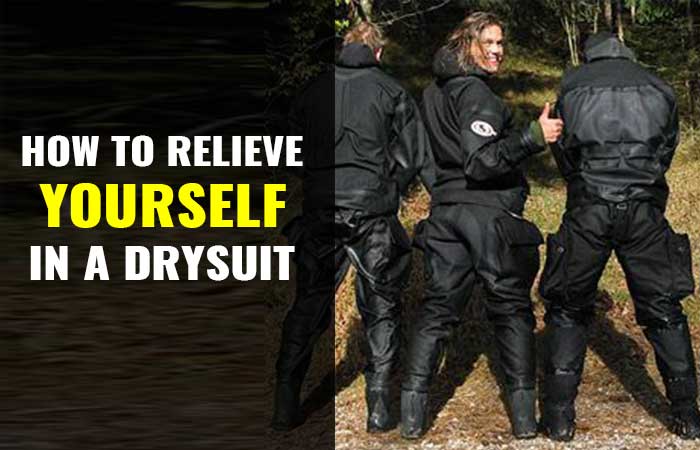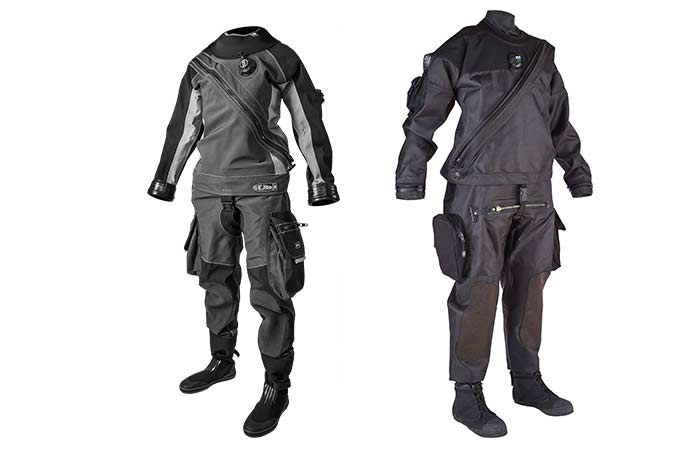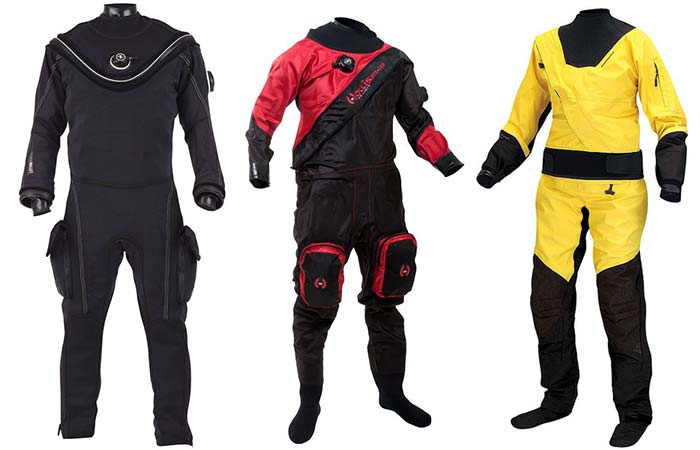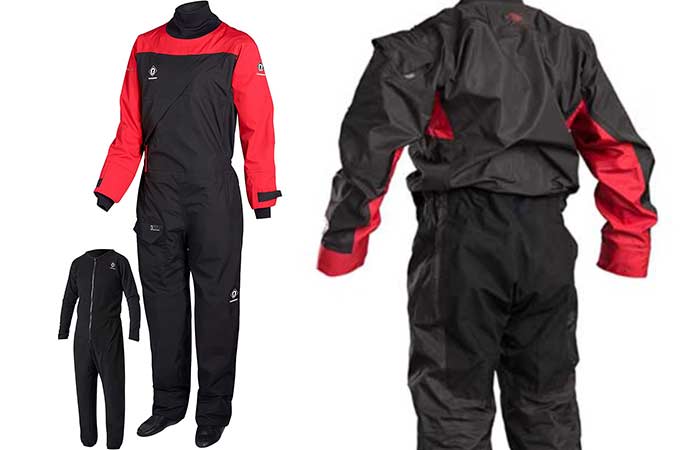Best Gloves for Drysuit + Buy Guide
When diving, having the right protection is paramount to your comfort and completing the tasks you set out to do. Most people using drysuits forget the all-important protection of their feet, hands and the head not knowing that not having protection for these parts of the body poses more danger than exposing the rest of the body.
For the hands, in particular, you will need them to be warm and protected from sharp objects and animal stings but still free enough to hold things and do other activities in the water. The answer to that is a pair of high-quality gloves that can be combined with your drysuit for the best level of protection and comfort.
We reviewed dozens of drysuit gloves focusing on aspects such as the materials used, the level of comfort, their style, thickness, closure and others. We settled on 7 of the best to go with your drysuit in different conditions.
TUSA Tropical Glove
First up is the TUSA Tropical Glove for diving in warm waters. This pair of gloves has a hook and loop wrist strap for a strong closure mechanism with sewn seams that keep it together avoiding any tearing when in use. It’s a full finger design hence covers the whole palm up to the wrist and into the arm of the drysuit.
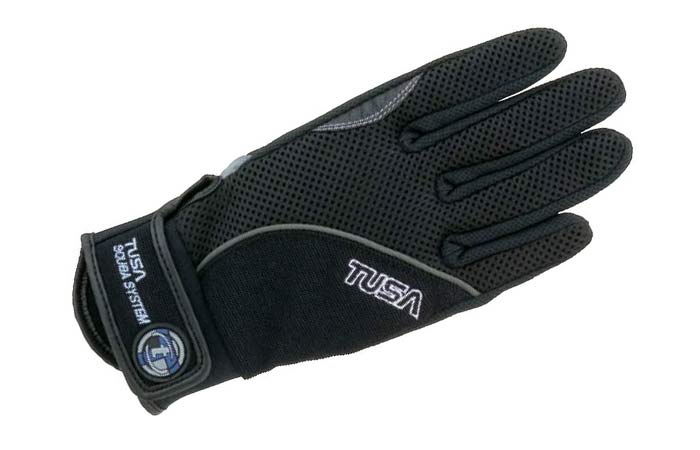
It has a textured palm design to add to the grip of the arm making it easy to grasp on items or adjust your gear while underwater. You also get a custom fit for the wrists thanks to its adjustable wrist strap. Beyond that, it has a soft and stretchy backing to add to your comfort.
Pros
- Hook and loop wrist strap for closure.
- Full finger design covers the whole arm.
- Made of high-quality Poly-Vinyl and Poly-Mesh materials.
- Sewn seams prevent tearing.
- Textured palms for extra grip.
- Lightweight and easy to travel with.
- Custom fit for the wrist closure.
- Soft and stretchy for extra comfort.
Cons
- Uninsulated hence suited only for warm waters.
Apart from being only suited to warm waters, these gloves are the most comfortable we ever tried.
XS Scuba 5mm Dry Five Pyrostretch Dry Gloves
These gloves look great and perform even better than they look. From the outset, they’re two simple black gloves that could pass for just about any pair of gloves. However, these are high quality Pyrostretch neoprene gloves at 5mm of thickness.
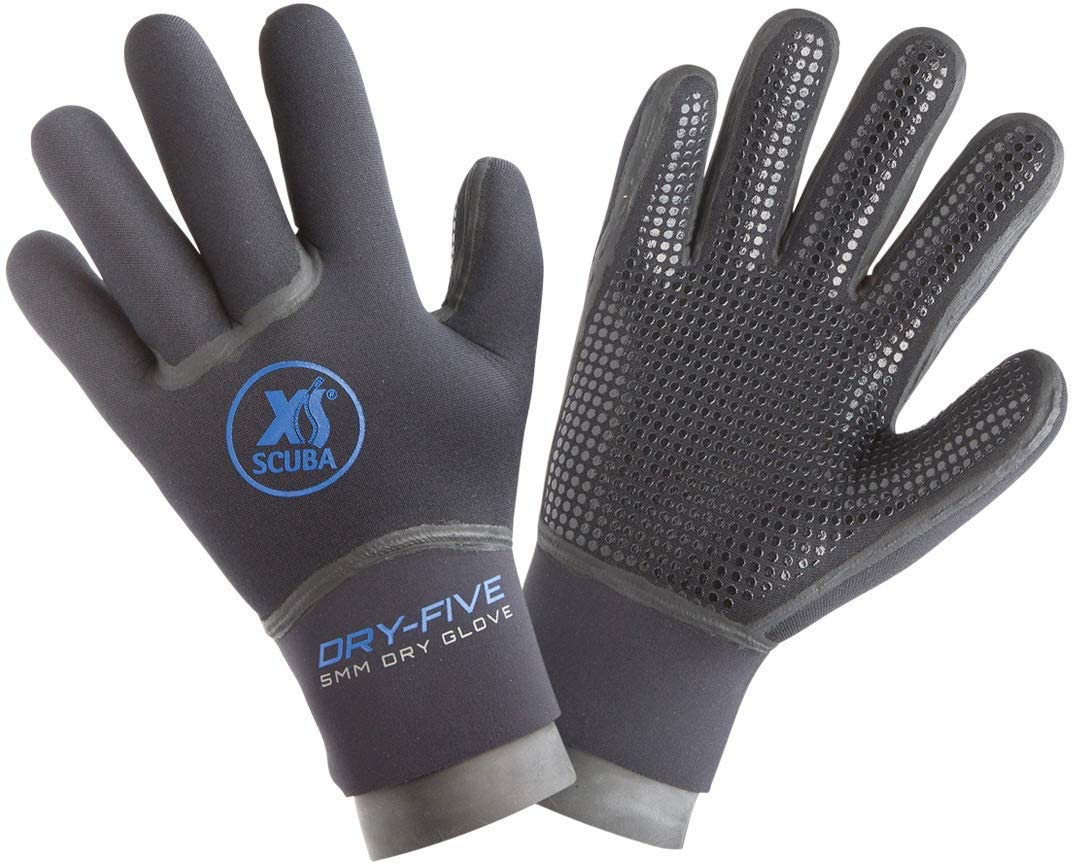
This means you can dive into the coldest of waters without feeling cold or having water come into contact with your hands. They have one of the best stretching factors ensuring they fit snuggly keeping out water and ensuring a good grasp. They come with a cool mesh bag packaging for ease of travel.
Pros
- 5mm thick for use in cold waters.
- Made of high quality Pyrostretch neoprene.
- High stretch for comfort and fit.
- Non-slip surface for proper grip.
- Waterproof to keep out the water.
- Cool mesh bag for easy packing and travel.
Cons
- None
With most cold-water diving drysuits being made of neoprene, this pair of gloves completes your look and gives you the confidence of knowing you can dive without getting cold or wet.
Lavacore Five Finger Gloves
This pair of gloves are made from a combination of Lycra, Merino sheep fleece and Stretch Polyurethane. What you get is a lightweight material that’s very warm and dries fast once you’re out of the water. For this reason, it’s used either as a primary glove or a layer on the skin where one can add another pair of gloves on it for use in cold waters.
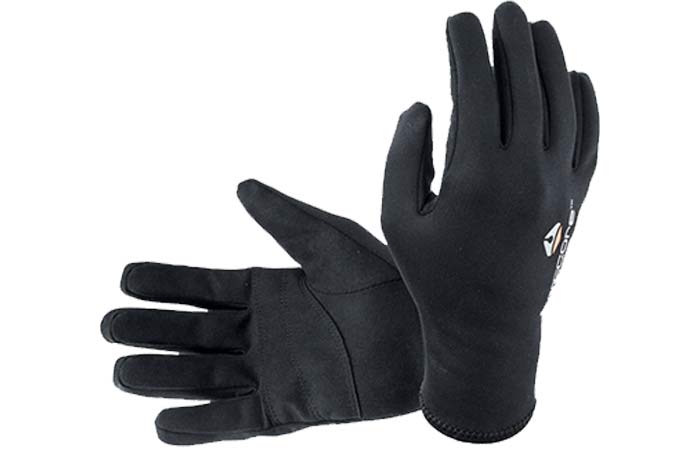
It has sewn seams and covers the whole hand up to the wrist for proper protection. It has a thin layer of material hence can’t be used in very cold waters on its own. However, it can be used for many different water activities including skiing and surfing.
Pros
- Made of Lycra, Merino Fleece and Polyurethane for comfort and durability.
- Full finger design for total palm protection.
- Overlapped flat lock seams keep the water out.
- Usable as the primary glove or as the inside layer.
- Added with a moisture wicking anti-bacterial layer for hygiene.
- Quick drying design.
Cons
- No closure
The lack of a closure is so that the gloves can be used for layering as well. Otherwise, these are highly comfortable and useful gloves in the water.
NeopSkin Water Gloves, 3mm and 5mm
These neoprene gloves can be used for just about any water sport or activity you can think of. From diving, swimming, surfing, sailing, rafting, snorkeling to kayaking and others, you can be sure these gloves will provide warmth and protection given their high-quality materials.

They’re available in 3mm and 5mm thicknesses with the thicker variant being suited to the cold waters. They have an anti-slip rubber surface on the inside to provide an assured grasp when in or on the water. The adjustable wrist closure with Velcro straps provides one of the best fits for your activities.
Pros
- Glued and blind stitched to prevent tearing.
- Flexible and stretchy for easy maneuvering and proper fit.
- Made of thick neoprene to provide warmth.
- Usable for multiple water activities.
- Anti-slip rubber surface for an accurate grip.
- Adjustable wrist closure for a custom fit.
- Unisex design.
Cons
- Not waterproof
Not being waterproof means that you’ll need to use them in slightly warmer waters or with a glove layering below them. Otherwise, they’re among the best on the market.
ScubaPro EverFlex Dive Gloves
The ScubaPro EverFlex are among the most flexible pair of diving gloves we tried on. Their design is also one of the most minimalistic as it doesn’t have a lot of moving parts. The rolled cuff makes it easy to put them on and take them off in a short while.
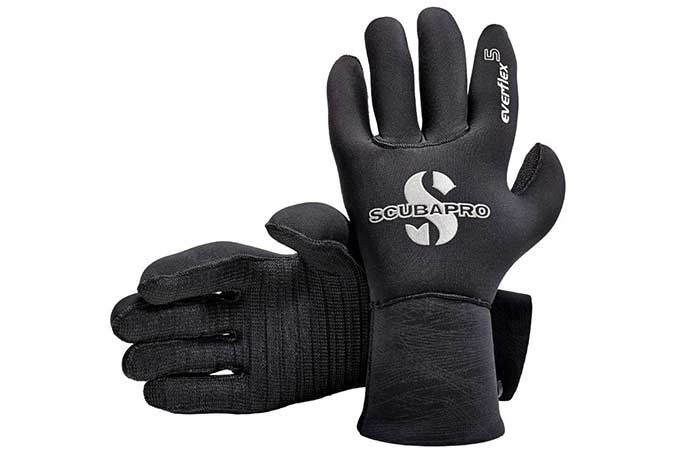
It’s made with 3mm of nylon 2 neoprene material which makes them durable. Add to the sewn and glued seams and you have yourself one of the most reliable pair of gloves. You may use them with an under layer for extra warmth since they’re just 3mm thick.
Pros
- 3mm thick for warmth.
- Glued and sewn seams make them tough and reliable.
- Made of high-quality nylon 2 neoprene.
- Full finger design for total arm protection.
- Rolled cuff closure lasts longer than other designs.
- Textured inside palm surface for added grip.
- Quick drying and water resistant on the outer layer.
- Easy to put on and take off.
Cons
- None
These are an easy choice if you’re looking for a way to keep your hands warm in the water.
Aqua Lung Thermocline Gloves
For those of us who hate struggling with gloves when going in and getting out of the water, the Aqua Lung Thermocline Gloves are a joy to use. They come with a closure system combining a zipper and hook and loop wrist strap. This makes it super easy to remove them and put them back on as you please.
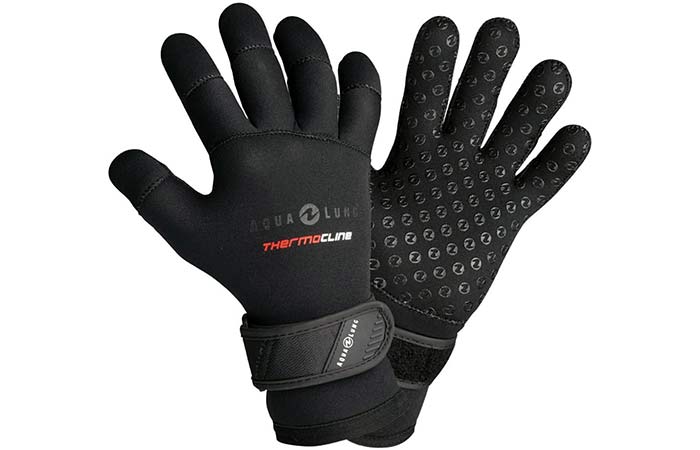
At 5mm of nylon 2 neoprene thickness, you can get your underwater tasks done underwater without getting cold or wet. The glued and sewn seams ensure a sturdy and fitting design that won’t let you down when it matters most.
Pros
- Zipper and hook and loop wrist strap for easy putting on and taking off.
- Full finger design for total palm coverage.
- 5mm thick for use in very cold waters.
- Nylon 2 neoprene.
- Textured surface in the palm for proper grip.
- Gusseted design for flexibility and warmth.
- Glued and sewn seams for sturdiness and fit.
Cons
- None
Apart from being a great pair of gloves in general, the highlight of this pair is the zippered design which allows faster donning and doffing.
Bare Three Finger Mitt
Made of nylon 2 neoprene material at a thickness of 7mm, the Bare Three Finger Mitt is the thickest of the drysuit gloves we tested. It wraps up our list of the best gloves although it could easily have taken a higher rank. It has seams that are sewn and double glued to remain resilient in the water.
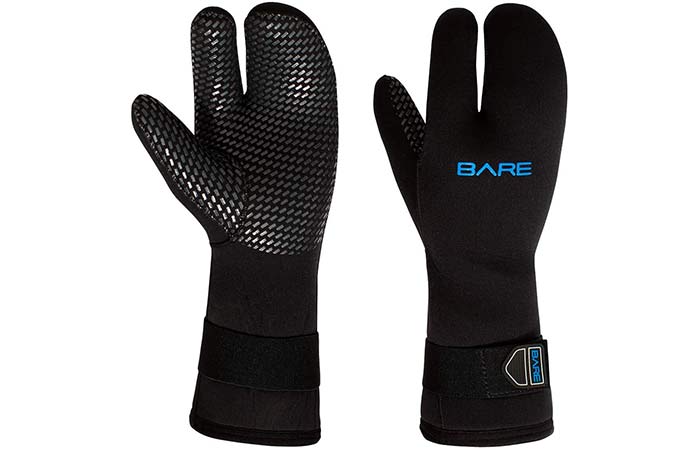
The three-finger name comes from the fact that it has a slot for the thumb, index finger and the third one for the other fingers. The textured palm adds grip and, given its gauntlet style cuffs, you get a very reliable fit. The 7mm of thickness make it the warmest pair of gloves we ever tried.
Pros
- Double glued and sewn seams.
- Gauntlet style cuffs.
- 7mm of thickness for use in cold waters.
- 3 finger mitten design.
- Nylon 2 neoprene is durable.
- Adjustable wrist closure for a custom fit.
- Blind stitched to keep the water out.
- Fingers pre-bent and cut for easy flexibility and grasping.
- Added grip with the textured surface.
- The gauntlet design provides warmth for a larger part of the forearm.
Cons
- None
Yet another great pair of gloves for your drysuit. At 7mm of thickness, it’s bound to be the warmest. To totally keep the water out, you need some waterproof layering on your palms and wrists.
Buyer’s Guide
To find the best gloves to go with your drysuit, consider the following aspects:
The fit
When it comes to gloves, there’s a sweet spot for everyone as they have to fit your specific hands to work well. You should also try both of the gloves for the best results as your hands aren’t exactly equal to one another. The same goes with your fit and other body parts that are in pairs.
When putting on the gloves, you should feel some medium level resistance that’s just enough to show that they’re fitting. After your hands are in, try making a fist with each one. Good gloves should allow easy movements but not be too loose that you don’t feel the gloves on your hands.
Keep in mind that gloves become much tighter when underwater. For this reason, you need just a good fit and not one that’s too tight that it inhibits your motions.
Thickness
The thickness of your gloves determines how much cold you can withstand in the water. In warm waters, a thin layer of materials at about 1mm will be enough to keep you warm. In slightly cold waters, between 3mm to 5mm is enough for most people. In really cold waters, you will need about 7mm of material thickness to stay comfortable. You can even add a layer of material below the main one for the best warmth and comfort.
Seams
Seams determine how secure your gloves will be in terms of withstanding pressure and keeping out water from reaching you. Sewn seams with blind stitching and flatlock designs can be enough for warm to mildly cold waters.
For colder waters, the seams will need to be both sewn and glued. For very cold waters, the seams may need to be taped, sewn and glued to provide warmth and keep the hands dry.
Style
There are three main styles of gloves with the choice between them being based on the task you will be carrying out and the temperature of the water. They are as follows:
Open finger gloves
Open finger gloves are meant to provide the least amount of protection and cover for the arms as they only cover from the wrist to the first half of each finger. This means that water can get underneath the hand and they should thus be used in warm waters only. They allow for easy manipulation of delicate machinery and tools such as cameras and others. The grip is also the most natural you can find.
Full finger gloves
Full finger gloves cover the whole of the palm and the wrist with the fingers fully covered. While they provide better insulation from the cold and the water, they can restrict your dexterity in the arms making it harder to operate delicate items in the water.
Dive mittens
For the very cold waters, dive mittens are the best as they group the fingers together making it easy to keep them warm. The focus is on warmth although they restrict what you can do with the arms. In most cases, the index finger and the thumb are separated from the rest allowing more freedom to move about and grasp objects.
Closure
The type of closure your gloves have dictate how easy (or hard) it will be to put them on and take them off. The basic types of closures simply require you to pull them on and off as you please. They, however, they provide the least amount of sealing for the palms as their seal easily allows water to enter. They also have a universal fit which won’t fit everyone perfectly.
The next level of closures are the hook and loop system. These ones have a Velcro tab which is used to adjust the tightness of the closure. You can thus have several people easily getting the perfect fit with these ones.
The best of the closures are the ones using combinations of zippers, semi-dry cuffs, gauntlets, hooks and loops. They provide watertight seals which ensure your palms remain warm and dry no matter the depth and temperature of the water.
Materials used
The materials used will dictate how much heat the gloves will retain from the body. The most used materials are Lycra, neoprene and rubber. These materials are the best in water although they act differently when it comes to heat. There are other materials such as latex that are also used with different results.
For these materials, you need to choose materials that will provide the best experience in terms of heat retention, looks, durability and they also don’t cause allergic reactions when worn.
With these aspects in mind, you can be sure to get the right pair of diving gloves for your drysuits.
More on Drysuits



